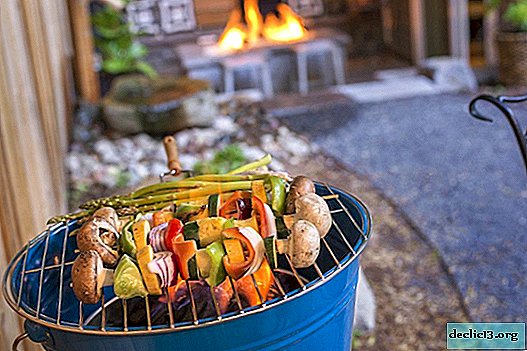Hybrid Tea Rose Grand Amore. Description of the plant, photos and practical recommendations for flower care

Hybrid tea roses are now one of the popular groups of modern roses. Bright red flowers have become a classic of floristry and a favorite color of roses.
Representatives of this color scheme are roses grand amore. This name translates as "great love."
In the article, you will read the description of this variety, including the history of occurrence and step-by-step instructions for care, as well as see a photo of a super gran amore rose.
Description
 Roses grand amore (Grande Amore) otherwise called super grand amore. Bright red flowers reach a size of 10 cm and have a mild delicate aroma. Foliage turns green gradually from reddish brown. One flower grows on the stem. The height of the bush is about 80 cm and a width of 40 cm. The bush is moderately branched, upright. It is neat and compact. The average grade for the grade is "good."
Roses grand amore (Grande Amore) otherwise called super grand amore. Bright red flowers reach a size of 10 cm and have a mild delicate aroma. Foliage turns green gradually from reddish brown. One flower grows on the stem. The height of the bush is about 80 cm and a width of 40 cm. The bush is moderately branched, upright. It is neat and compact. The average grade for the grade is "good."
Grand amore is poorly resistant to powdery mildew, they will need constant prevention. To black spotting resistance is average. Flowering: re-blooming. When the rain flowers do not open, but the rose hibernates well and stands well in a vase. The variety is suitable for cutting.
History of occurrence
Variety bred in Germany in 2004. In 2005, this variety was awarded the German Allgemeine Deutsche Rosenneuheitenprüfung (ADR) prestigious award for resistance to the negative impact of a metropolis.
What is the difference from the other varieties?
Very large flowers distinguish from the other roses of grand amore. In the second year, they can reach 20 cm. This rose is a representative of floral classics, its petals are gracefully laid. Each petal bends outward. Blooms profusely to the very frosts.
The variety is suitable for planting in park areas, private household plots and for cutting.Bloom
When and how does this happen?
Grand amore is a re-flowering variety. After the first wave of flowering, the buds must be cut off, otherwise the flowers will not appear anymore this season. Dense buds, flowers of a goblet shape. When fading, the petals fall off.
Content Features
Standard care for the variety does not have any features. Timely care of the plant will give a qualitative result: top dressing, watering, weeding from weeds or treatment with herbicides, protection from diseases and pests. It is advisable to take care of Grand Amore additionally if the summer is very rainy, as the flowers may not bloom.
What to do if it does not bloom?
Not all roses bloom in the first year after planting. This is the norm. But already in the second year of flowering, buds can reach enormous amounts. Also, flowering may not be due to lack of sunlight (at least 8 hours a day), improper pruning (buds must be removed after flowering), improper feeding, root shoots, bacterial burns, aging (bushes older than 3 years must be rejuvenated).
Photo
The photo shows how this variety looks.





Use in landscape design
Grand amore red roses look spectacularly in the form of monoplanting, in Art Nouveau compositions. It will reveal the beauty of the flower and the classic landscape style. The combination of blood red and dark green favorably emphasizes the sophistication of the shape and brightness of the buds.
Hybrid tea rose Grande Amore, having high winter hardiness, deservedly occupies the best places in flowerbeds of Russia and in the hearts of gardeners. Looks spectacular on the flowerbed and lawn.Step-by-step care instructions
 Choosing a landing place. The variety prefers sunny areas, without drafts and gusts of wind.
Choosing a landing place. The variety prefers sunny areas, without drafts and gusts of wind.- Landing time. The optimal time for landing in the middle lane is the beginning of May. The soil should have time to warm up well.
- What should be the soil. Acidity of suitable soil is 5.5-7.2 ph. It is important to provide plants with good drainage. A pit is dug at least 60 cm. Layers of 10 cm are laid on the bottom: drainage, organic fertilizers. Then fertile soil is added.
- Landing. After acquiring seedlings with an open root system, they are treated with a disinfector and kept for 24 hours in water or a root growth stimulator. Landing with an earthen lump is also possible.
Seedlings must be purchased in nurseries or other proven places of trade in young plants.
- Temperature. Rose withstands frosts down to -8 ° C. For the winter, the bush should be covered. Frost resistance zone (USDA): 6a (from -20.6 ° C to -23.3 ° C)).
- Watering. In a temperate climate and not hot weather, watering is performed once a week. With heat, it is necessary to moisten the plants twice in 7 days. Under the bush, at least 5 liters of non-cold water are required. Watering should be done carefully, without touching flowers and leaves.
- Top dressing. Nitrogen fertilizers make in the spring, potassium phosphorus in the summer. The entire growing season, you can feed bushes with folk and organic fertilizers (vermicompost, compost, eggshell).
- Weeding. Regular weeding from weeds will protect the plant from diseases and loss of nutrients, as well as provide a clean and aesthetic appearance of the garden.
- Pruning:
- Preventive. The first pruning will be precisely prophylactic: the removal of diseased and damaged stems. The third pruning is done in the fall and is preventative in nature. You need to remove weak, thin or broken shoots.
- Formative. The second pruning is done in the summer. It is necessary to remove dried buds with a small area of the stem. You can form a bush during the growing season. Correct forming pruning allows you to give the bush almost any shape and does not affect flowering.
 Transfer. In early spring or autumn, it is appropriate to transplant an adult plant. If the rose blooms, then you will have to remove all the buds. To transfer the bush to a new place, an earthen lump on the roots is preserved, and the stems are severely trimmed.
Transfer. In early spring or autumn, it is appropriate to transplant an adult plant. If the rose blooms, then you will have to remove all the buds. To transfer the bush to a new place, an earthen lump on the roots is preserved, and the stems are severely trimmed.- Preparation for winter. Despite the high winter hardiness, Grand Amore harbor for the winter period. Sprinkle the root system with sand or soil, spud. The layer should be 20-30 cm.
The plant itself is insulated with spruce spruce branches, covered with non-woven material and polyethylene, leaving side products. When spring comes, the plant is opened for ventilation, and then fully opened in established warm weather. If the plant is not opened in time, then it can overheat.
How to propagate?
For propagation, lignified half-shoots are suitable. Young shoots or shoots treated with nitrogen fertilizers are not suitable. One of the ways is the cuttings in a bag filled with water. The shoot is placed there until the roots appear.
It is better to cut the shoots for reproduction in the morning or in cloudy weather.Another method of propagation by cuttings:
- Cut off a suitable escape. Upper and lower cut 45 °.
- Leave 2 sheets on the handle, remove the soft part.
- The dried cuttings are planted in the ground 2-3 cm in a shady place.
- A young rose is covered with a jar or a bottle and periodically sprayed.
- The surviving specimen is left to winter in this place. In spring, you can transplant as needed.
Diseases and Pests
 If the summer turned out to be rainy, 1-2 treatment of the rose from diseases will be required. Processing with preparations containing sulfur will help. Other diseases of roses: powdery mildew, rust, gray rot. The main diseases of flowers are precisely fungal infections. Also, the variety can be affected by pests: a bear, a spider mite, a rosette leaflet, a scabbard, a penny.
If the summer turned out to be rainy, 1-2 treatment of the rose from diseases will be required. Processing with preparations containing sulfur will help. Other diseases of roses: powdery mildew, rust, gray rot. The main diseases of flowers are precisely fungal infections. Also, the variety can be affected by pests: a bear, a spider mite, a rosette leaflet, a scabbard, a penny.
Insecticides are used to control insects. Powdery mildew is destroyed by Bordeaux fluid. And for the prevention of viruses that carry insects, seedlings must be disinfected.
The red flowers of the Grand Amore variety are fascinating and eye-catching. Resistance to diseases and cold makes it possible to widely use this unpretentious variety in a garden or city park. But despite the persistence of the rose, it should still be sheltered for the winter and prevent diseases and pests, as well as provide care in a timely manner.

 Choosing a landing place. The variety prefers sunny areas, without drafts and gusts of wind.
Choosing a landing place. The variety prefers sunny areas, without drafts and gusts of wind. Transfer. In early spring or autumn, it is appropriate to transplant an adult plant. If the rose blooms, then you will have to remove all the buds. To transfer the bush to a new place, an earthen lump on the roots is preserved, and the stems are severely trimmed.
Transfer. In early spring or autumn, it is appropriate to transplant an adult plant. If the rose blooms, then you will have to remove all the buds. To transfer the bush to a new place, an earthen lump on the roots is preserved, and the stems are severely trimmed.















